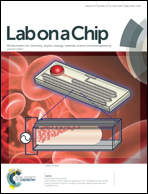Dynamic interplay of flow and collagen stabilizes primary hepatocytes culture in a microfluidic platform†
Abstract
The creation of stable flow cultures of hepatocytes is highly desirable for the development of platforms for drug toxicity screening, bio-artificial liver support devices, and models for investigating liver physiology and pathophysiology. Given that hepatocytes cultured using the collagen overlay or in ‘sandwich’ configuration maintain a wide range of differentiated functions, we describe a simple method for adapting this culture configuration within a microfluidic device. The device design consists of a porous membrane sandwiched between two layers of PDMS resulting in a two-chambered device. In the bottom chamber, hepatocytes are cultured in the collagen sandwich configuration, while the top chamber is accessible for flow. We demonstrate that hepatocytes cultured under flow exhibit higher albumin and urea secretions and induce cytochrome P450 1A1 activity in comparison to static cultures. Furthermore, over two weeks, hepatocytes cultured under flow show a well-connected cellular network with bile canaliculi formation, whereas static cultures show formation of gaps in the cellular network that progressively increase over time. Although enhanced functional response of hepatocytes cultured under flow has been observed in multiple prior studies, the exact mechanism for this flow induced effect remains unknown. In our work, we identified that hepatocytes secrete a higher level of collagen in the flow cultures; inhibiting collagen secretion within the flow cultures reduced albumin secretion and restored the appearance of gaps in the cellular network similar to the static cultures. These results demonstrate the importance of the increased collagen secretion by hepatocytes cultured under flow as a mechanism to maintain a well-connected cellular network and a differentiated function.


 Please wait while we load your content...
Please wait while we load your content...